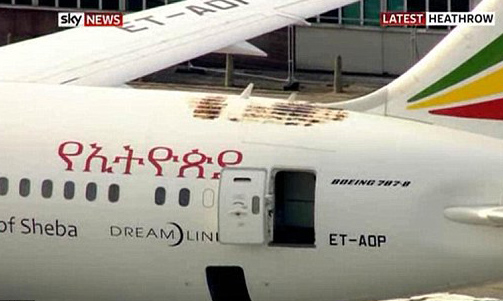Honeywell ELT Blamed for Boeing 787 Fire at Heathrow
Perhaps one reason an emergency locator transmitter might not have worked as designed upon impact of an aircraft on sea or land is if it had been the cause of the emergency in the first place. Albeit a remote possibility, this adds one more possible explanation for the disappearance of Malaysian Airline MH370 on March 8, 2014 and the absence of any transmission from the Honeywell designed ELTs. Last year, on July 12, 2013 an unoccupied Ethiopan Airlines 787 Dreamliner caught fire in what investigators would later trace back to either a set of lithium-manganese dioxide-based chemical batteries that powered the Honeywell RESCU 406® AFN Emergency Locator Transmitter or “wiring installation discrepancies.”
Boeing confirmed that the 406® AFN was the same model that was installed on all Dreamliner 787 aircraft. In the ensuing investigation aviation safety agencies including the United Kingdom’s Air Accidents Investigation Branch (AAIB), Canada’s Continuing Airworthiness Division (AARDG) and the U.S. Federal Aviation Administration (FAA) all issued directives aimed at removing or inspecting the Honeywell devices.
Subsequently, Boeing issued a recommendation to operators of Boeing 717, Next-Generation 737, 747-400, 767 and 777 to inspect the aircraft’s ELT unit(s).
This battery issue with the Boeing 787 Dreamliner is a separate one from the earlier, more publicized Dreamliner/Lithium-ion battery concerns that occurred in late 2013 and early 2013. The earlier problem was traced to a different set of lithium batteries on the Boeing plane. Because of the sole purpose of the product in radiating a satellite signal after a catastrophic event, the Honeywell ELT is purposely powered independently of the aircraft’s electrical system. It contains a set of chemical batteries using a Lithium-Manganese Dioxide (LiMnO2) composition that allow the ELT, as required by regulation, to operate in an emergency situation entirely independent of the aircraft’s electrical power system.
As far as locating the missing Malaysia Airline MH370 aircraft goes, there may be an additional ELT located in the plane’s life rafts. Honeywell manufactures and sells the RESCU 406®S ELT which is activated automatically upon immersion in seawater. These are often installed in life rafts or emergency slides and would begin radiating a signal upon the unit touching water.
Each Honeywell ELT model is designed to be crash survivable and radiate a fully automatic triple frequency signal. Radiation occurrs within seconds on the civil emergency frequency of 121.5 MHz, the military emergency frequency of 243 MHz, and the COSPAS-SARSAT emergency frequency of 406.025 MHz.
Honeywell
Honeywell Chairman and CEO David Cote was named 2013 CEO of the Year by Chief Executive magazine. In March 2014, Cote was elected to the board of the Federal Reserve Bank of New York. Cote’s compensation rose last year to $25.4 million. As part of his compensation, he also received options to acquire 750,000 shares of Honeywell stock – as of March 26, 2014, NYSE: HON was listed at $92 per share.
Honeywell has made no public comments about their electronic locator transmitters or the investigation behind the disappearance of Malaysia Airline MH370.






